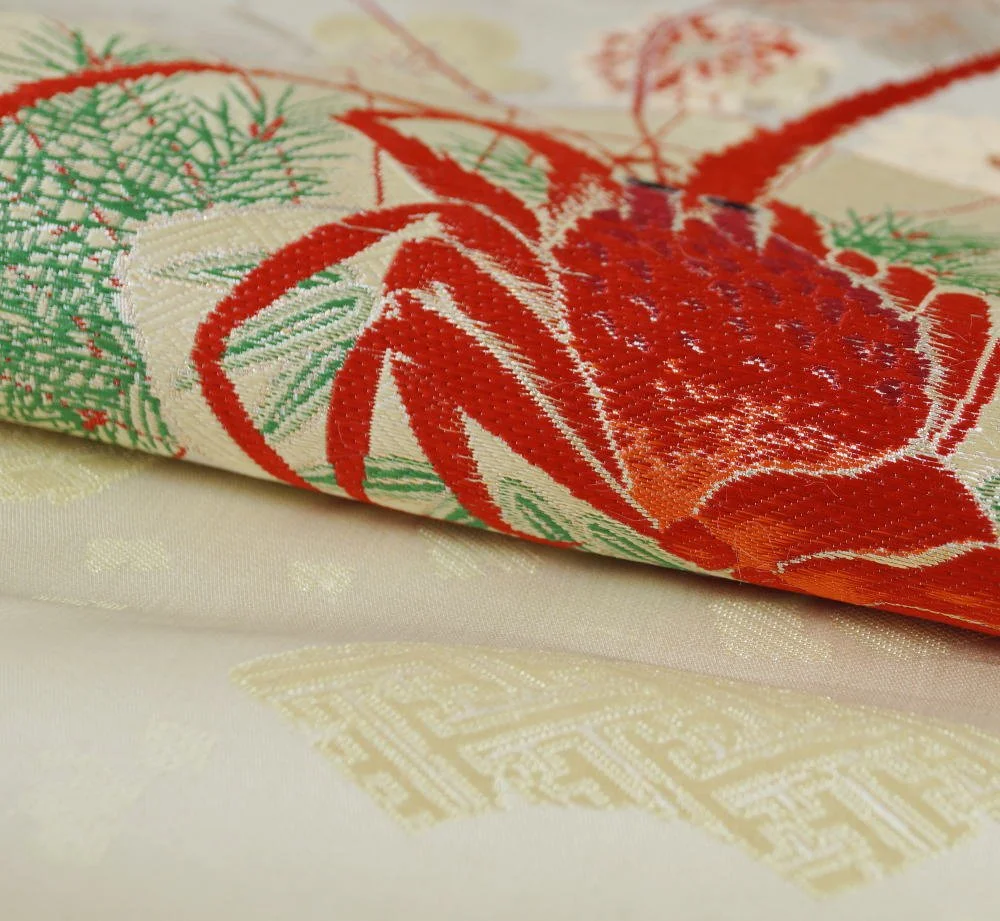Japanese garden, in landscape design, a type of garden whose major design aesthetic is a simple, minimalist natural setting designed to inspire reflection and meditation.
Read More
Japanese garden, in landscape design, a type of garden whose major design aesthetic is a simple, minimalist natural setting designed to inspire reflection and meditation.
Read MoreA few new rokutsugara obi have been added to the store. Rokutsugara is an an obi that repeats the pattern 6 times. There is an unpatterned space in the middle of the obi, and it has a kaikirisen also for wearing in a taiko musubi. he knot tied with the obi is known as the musubi (結び/むすび, "knot"). Though obi functioned to hold the kimono closed for many centuries, beginning in the Edo period, the obi became too wide and/or too stiff to function effectively in this manner. In the modern day, a number of ties and accessories are used to keep the kimono in place, with the obi functioning in a more decorative capacity. Though most styles of obi musubi can be tied by oneself, some varieties of formal women's obi can be difficult to tie successfully without the assistance of others.
There are hundreds of decorative knots, particularly for women, often named for their resemblance to flowers, animals and birds. Obi knots follow the same rough conventions of style and suitability as kimono do, with the more complex and fanciful knots reserved for younger women on festive occasions, and knots with a plainer appearance being mostly worn by older women; however, some knots, such as the taiko musubi, have become the standard knot for women of all ages, excluding young girls. In earlier days, the knots were believed to banish malicious spirits. Many knots have a name with an auspicious double meaning.
Read MoreTsuru, (The Crane), has always been a strong symbol of success and good fortune in Japanese culture, and when folded into origami, it is believed that one’s “heart's desire” will come true.

Tsuru no Ongaeshi (鶴の恩返し)
Tsuru no Ongaeshi (鶴の恩返し, lit. "Crane's Return of a Favor") is a story from Japanese folklore about a crane who returns a favor to a man. A variant of the story where a man marries the crane that returns the favor is known as Tsuru Nyōbō (鶴女房, "Crane Wife").
According to Japanese scholar Seki Keigo, the story is "one of the best known" tales in Japan about supernatural and enchanted spouses.
A man saves a crane that had been shot down by hunters. That night, a beautiful girl appears at the man's door and tells him that she is his wife. The man tells her that he is not wealthy enough to support them, but she tells him that she has a bag of rice that will fill their stomachs. Every day, the rice never goes down in the sack, and it always stays full. The next day she tells the man that she is going in a room to make something and that he is not to come in until she is finished. Seven days have passed by and she finally comes out with a beautiful piece of clothing, but she is very skinny. She tells the man to go to the markets the next morning and to sell this for a very large price. He comes back home and tells her that he sold it for a very good price. After that, they are now wealthy. The wife then goes back into the room, telling him once again not to come in until she is finished. The man's curiosity takes over and he peeks in, realizing that the woman is the crane whom he saved. When the crane sees that the man has found out her true identity, she says that she cannot stay there anymore and flies away to never come back.
In The Crane Wife story, a man marries a woman who is in fact a crane disguised as a human, To make money the crane wife plucks her own feathers to weave silk brocade which the man sells, but she becomes increasingly ill as she does so. When the man discovers his wife's true identity and the nature of her illness, devastated by the truth he demands her to stop. She responds that she has been doing it for love, for them. The man says that love exists without sacrifices but he is wrong. He who lives without sacrifices for someone else doesn't deserve to be with a crane.

Wearing the Tsuru Motif
The crane is a bird of winter as kimono Motif, associated with the month of November.

Ebi can also be referred to as Ise Ebi (伊勢海老) which is a particular species of spiny lobster found in Mie prefecture. The hunched back and whiskers of the ebi are features that are also attributed to an old man and because of this, ebi is considered a symbol of long life. It is often nicknamed the old man of the sea. Ebi can also be referred to as Ise Ebi (伊勢海老) which is a particular species of spiny lobster found in Mie prefecture.
Ebi will resemble a lobster or a shrimp with a curved back, long whiskers on its face, and six legs.
Ebi can play two different roles as a motif, that of a seasonal motif, and that of an auspicious motif. Ebi is a staple ingredient in Osechi, the traditional New Year’s selection of food.
Read MoreFall gardens have room for traditional Japanese vegetables and greens.
Read MoreFrom ancient times, beautiful artistic patterns on kimono have reflected the Japanese people’s delicate senses towards the changing seasons and how social conventions in the country have changed through its history. We will explore the meanings behind the designs as well as insights into styling a kimono attire.
Read More